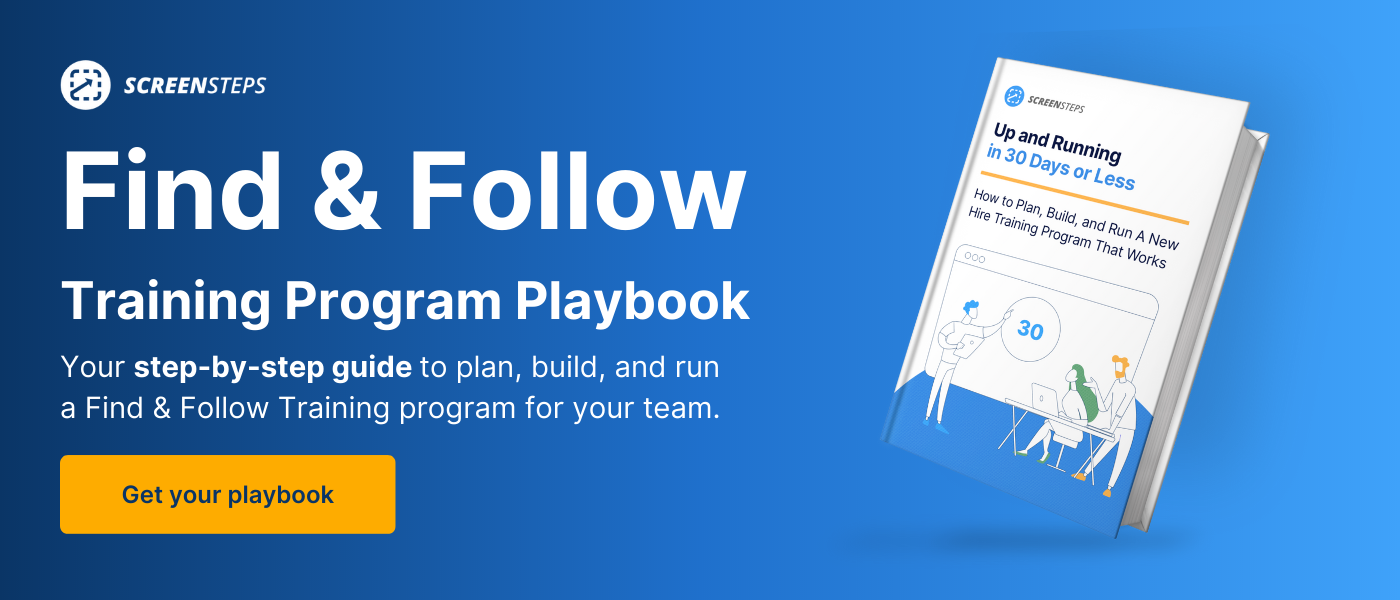How to Train Employees to Be Self-Reliant (4 Keys)
If you’ve completed training a new group of employees using traditional methods (i.e. lecturing and demoing what to do), then you’re probably experiencing the following after training is over...
Employees require a lot of hand-holding to do their jobs and supervisors answer frequent questions like: “How do I do this?” “Where do I find that?”
In fact, your employees rely on supervisors to jump in and answer questions, which is eating up your supervisors’ time and is inefficient as it requires two people to do one job.
All of those things can be very frustrating to trainers, managers, and supervisors.
As a content and training coach for ScreenSteps — a knowledge base and training software company — I’ve worked with dozens of companies that have this exact problem. They develop a training program, but it isn’t preparing employees to handle their jobs on their own.
How do you help employees become more self-reliant?
Here are four keys to helping you build a culture of independence in your workspace. When done correctly, it frees up the supervisor’s time and helps your employees gain confidence.
1. Have a reliable resource
Before training even begins, you must first build reliable resources. By reliable, I mean that the job aids and help guides can stand on their own.
These are job aids that walk someone through a standard operating procedure (SOP) from start to finish without needing additional support. The guides contain all the necessary information an employee needs to follow and handle a procedure.
Some job aids that you may consider documenting include:
- Reference guides
- Step-by-step procedures
- Policies
- Call flows
- Call center scripts
If your procedures and job aids are inaccurate or incomplete, then nobody will trust them. Employees won’t use untrustworthy resources, so you need to ensure your guides are up to date with the most current information.
This step is critical. Without reliable help guides, your employees will always be reliant on others — co-workers and supervisors — who have more procedural knowledge than them.
Create guides for every policy, process, and procedure your employees could handle on the job. Make sure those procedures are complete, covering every possible outcome and decision tree.

2. Ensure those resources are easily accessible
Having resources is great, but they won’t do your employees any good if they can’t access the most up-to-date and accurate guide.
Use cloud-based software to create a centralized location where employees know they can go to find all the guides.
There are software options available to help you manage your documents and company knowledge. We recommend using a knowledge base. With a knowledge base, you have a one-stop shop where you can create, store, and share your resources.
Other knowledge management and document management tools include:
- Call flow software
- Document library
- Intranet
- Wiki
3. Train employees on how to use your resources
During training, focus on teaching your employees how to access the guides and follow the instructions. You are essentially teaching people how to “Google it” and “follow the steps.”
Training employees on how to use your resources is a two-part process: (1) you teach them the nuisances of reading the guide and (2) then you have them practice using the guides.
I. Teach employees how to read the guides
Many learners are not comfortable with following instructions. They rush through them, skip important steps, and gloss over information.
Your guides should be easy for your employees to read and follow on the job. Part of making those job aids easy to understand is teaching your employees how to read them.
What do words written in italics mean? What does a red highlighted box indicate?
Teach your employees how to read/skim and follow your guides. If you do this right, they won’t need to stop what they are doing to read and understand the instructions.
II. Practice using the guides
After going over how to read the guides, have employees role-play scenarios. This is often referred to as scenario-based training. Have as many hands-on practice sessions as possible. This will give your employees real-life training before starting their jobs.
During training, you bring up situations to which your learners don’t know how to respond. These are areas they may get stuck. In these situations, they are going to ask you for help.
Don’t answer them. Direct them back to the instructions. Instead of answering the question, you are going to ask, “What does the article say?”
This may feel uncomfortable at first. You may feel this is harsh or contradictory for a training session. It takes a lot of discipline and focus to refer trainees back to the knowledge base instead of spoon-feeding them the answers. But, it’s critical you follow this step.
Why? Because you are teaching your employees to rely on your documented articles. They learn to turn to your guides for answers.
Think about how young kids learn. Children ask for help putting on a coat, but it is only after you let them struggle that they figure it out for themselves.
Trainees do that too. They need to learn to trust themselves and then they have more confidence in themselves and the guides you provide them with.
Quick tip: Don’t be the hero
Often, trainers want to be the hero. They don’t want the learners to struggle. They want to rescue the new hires when they don't know what to do, but that teaches reliance on the trainer.
Every time they ask you for help, the only thing you’re going to do is guide them on how to find the answer in the document management or knowledge management system you use.
4. Return the responsibility
Once training is complete, continue what you began in training. Point them back to your job aids and resources.
When they have questions, return the responsibility for finding answers to the employees. Don’t let them fall back on hold habits of asking supervisors to spoon feed them answers. Ask them, “What do the instructions say? Where does it say to click? What does it say to do?”
You are teaching them how to find answers and follow steps on their own so that when they begin work, they are self-reliant. Not that they’re experts or have everything memorized, but they know how to use your resources to do their tasks.
If you always step in, that’s what we call snow plow training. Snowplow training is based on the term snowplow parenting. It is when parents (or trainers in the workplace) move obstacles out of their child’s (trainee’s) way.
This makes the path easier for the learner at the time but teaches them dependency on someone else to solve their problems.
Reminder
Learners are going to struggle. Let them! Give them time to find the resource and follow the steps. It takes a while the first time they do it. It could take them 20 minutes to do a simple procedure. Then it goes faster after that.
Build confident and self-reliant employees with an empowering training curriculum
Learning everything there is to know about a new job takes a lot of work. Break the mold of employees who rely on your team leaders. Provide them with the tools and training they need to feel confident on the job.
With a ScreenSteps knowledge base, your employees have the answers they need at their fingertips. They can access the answers they need in as few as two clicks.
Once you have the right tools in place, the best thing you can do for your employees is to develop a training curriculum that instills confidence and points them back to your knowledge base.
With a knowledge base at the core, ScreenSteps’ Find & Follow Training Framework works for any company looking to empower its employees. It helps you develop a training program that turns out knowledgeable, confident, and efficient employees in 30 days or less.
What does the Find & Follow Training Framework involve? Download this free eBook for an overview of Find & Follow.


.png)
